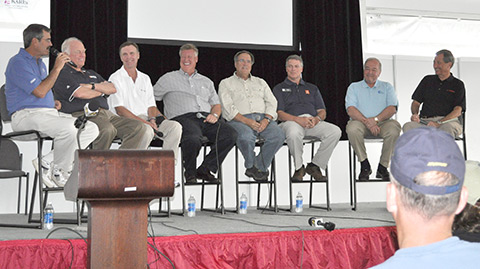
Left to right: Mac McClellan (EAA moderator), Jim Coyne (NATA), Ed Bolen (NBAA),
Rod Hightower (EAA), Craig Fuller (AOPA), Pete Bunce (GAMA), Matt Zuccaro (HAI),
and Henry Ogrodzinski (NASAO)
What affects one segment of the aviation industry ultimately affects everyone involved in aviation, be they business jet owners, helicopter pilots, or airport operators, the leaders of the industry associations said July 27 in a roundtable discussion at EAA AirVenture.
“We are, in fact, all part of the general aviation community, and anything that affects one segment affects us all,” said Ed Bolen, president and CEO of the National Business Aviation Association. Bolen was joined by Pete Bunce, president and CEO of the General Aviation Manufacturers Association, James Coyne, president of the National Air Transportation Association, AOPA President Craig Fuller, Experimental Aircraft Association President Rod Hightower, and Matthew Zuccaro, president of Helicopter Association International.
The organizations have joined together to fight the issues that threaten aviation, and the group leaders agreed that a united front has helped them to gain a stronger voice on Capitol Hill. “Our strength is growing and we are making a difference, collectively,” Bolen said.
Some of the issues facing the industry include privacy rights for personal aircraft, user fees, and the dwindling pilot population. Hightower said EAA is poised to sharpen its focus on nurturing the next generation of aviators by helping Young Eagles participants—some 77,000 per year—progress beyond first flights to actually completing their certification. Financial support and mentoring are approaches that will be used, he said.
AOPA’s Flight Training Retention Initiative is working to pinpoint successful and not-so-successful practices within the training community so as to improve the student pilot retention rate, Fuller said. An alarming 70 percent to 80 percent of student pilots never complete their training to become pilots, he said. What makes this number especially troubling is that “we’re going to face a pilot shortage,” he said. “The airlines tell us that. They’re looking to the GA community to address that.”
User fees, once thought to be off the table, cropped back up in the most recent round of budget negotiations, Fuller said. “That is not the way to raise [revenue],” he said. “It creates a new bureaucracy.” Unless we convince Congress now that it doesn’t raise money in the proper way, we’ll be at risk, he explained.
Bunce pointed to President Barack Obama’s recent statement that accelerated depreciation, which makes it more cost-effective to purchase a new aircraft, is too generous and that owners can afford to pay more. The president’s declaration came only several months after he had proposed to accelerate the depreciation schedule in an effort to encourage businesses to invest by reducing their tax burden on new purchases. “It’s inconsistent,” Bunce said. “It hurts an industry. The [fewer] airplanes we sell the more the unit cost goes up. We have to have an administration and Congress that care about the aviation industry.”
Challenges facing the helicopter industry include administrative and regulatory agencies that misdirect their attention to a small percentage of helicopter accidents—those involving emergency medical transport, Zuccaro said. “We’re not targeting the real issue and the real problem,” Zuccaro said. “The majority of accidents are Part 91 [operations]—personal flying and training.” Another source of concern is the FAA’s heliport design advisory circular, which is being rewritten. “It’s clearly an advisory circular, but it has stronger and stronger language coming into it,” he said. Numerous states are taking the design guide and making it mandatory compliance, which constrains construction of new helicopters and improvements to existing facilities.



